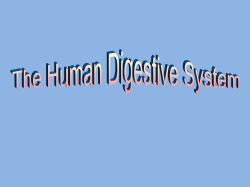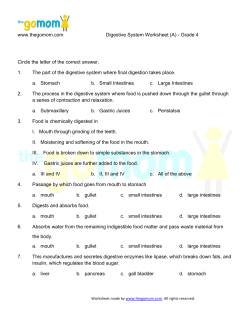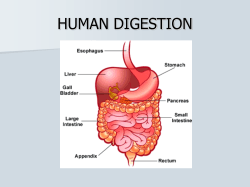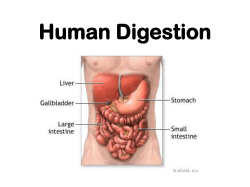
File
A&P- Ch. 16 REVIEW True/False Indicate whether the statement is true or false. ____ 1. Another name for tooth decay is dental caries. ____ 2. Ingestion is the taking in of food by the body. ____ 3. Digestion is the passage of food from the digestive tract into the bloodstream. ____ 4. Another name for the gastrointestinal tract is the alimentary canal. ____ 5. Hanging from the posterior border of the soft palate is a cone-shaped muscular structure called the villi. ____ 6. The tongue and its associated muscles form the floor of the oral cavity. ____ 7. Saliva is 99.5% water, which provides a medium for dissolving foods. ____ 8. Forty temporary, or deciduous, teeth form in infants between the ages of six months to two years. ____ 9. The function of the esophagus is to produce digestive enzymes and absorb food. ____ 10. The zymogenic, or chief cells, within the mucosa of the stomach secrete the principal gastric enzyme pepsinogen. ____ 11. The main chemical activity of the stomach is to begin the digestion of proteins with the enzyme pepsin. ____ 12. The beta cells of the islets of Langerhans in the pancreas secrete the hormone insulin. ____ 13. The Kupffer’s cells of the liver phagocytose certain bacteria and old, worn-out white and red blood cells. ____ 14. The liver is one of the smallest organs of the digestive system. ____ 15. Taste buds are found on the filiform papillae. ____ 16. Mumps is caused by a bacterial infection of the salivary glands. Multiple Choice Identify the choice that best completes the statement or answers the question. ____ 17. The folds of the mucosa on the internal surface of the stomach are called ____. a. gingivae c. plicae b. rugae d. gyri ____ 18. An inflammation of the liver caused by a viral infection or by excessive alcohol consumption is known as ____. a. hepatitis c. appendicitis b. pancreatitis d. gingivitis ____ 19. A long-term degenerative disease of the liver in which the lobes are covered with fibrous connective tissue is called ____. a. Crohn’s disease c. cirrhosis b. Conn’s disease d. hepatitis ____ 20. An inflammation of the vermiform appendix, caused by an obstruction, is known as ____. a. hepatitis c. appendicitis b. pancreatitis d. gingivitis ____ 21. A chronic, inflammatory bowel disease of unknown origin with symptoms of diarrhea, severe abdominal pain, fever, chills, nausea, weakness, anorexia, and weight loss is known as ____. a. Crohn’s disease c. cirrhosis b. Conn’s disease d. hepatitis ____ 22. A soft mass of chewed food ready to be swallowed is known as (a) ____. a. plicae c. chyle b. chyme d. bolus ____ 23. Approximately 80% of all absorption of nutrients occurs in the ____. a. stomach c. large intestine b. small intestine d. mouth ____ 24. The folds of the mucosa of the small intestine, which increase the surface area for absorption of nutrients, are called ____. a. plicae c. chyle b. chyme d. bolus ____ 25. A bacterium associated with the development of stomach or peptic ulcers is ____. a. Helicobacter pylori c. Escherichia coli b. Entamoeba histolytica d. trichomoniasis ____ 26. The portion of the tooth above the level of the gums that is covered with enamel is the ____. a. root c. crown b. neck d. pulp ____ 27. A condition caused by the protrusion of a portion of the stomach through the opening in the diaphragm is known as ____. a. hiatal hernia c. umbilical hernia b. inguinal hernia d. gastric ulcer ____ 28. The pear-shaped sac about three to four inches long that stores and concentrates bile until it is needed in the small intestine is the ____. a. pancreas c. liver b. spleen d. gallbladder ____ 29. The physical movement or pushing of food along the digestive tract in wave-like movements is known as ____. a. peristalsis c. reabsorption b. absorption d. digestion ____ 30. The digested, viscous, semi-fluid contents of the small intestine are known as ____. a. plicae c. chyle b. chyme d. bolus ____ 31. The presence of pouch-like herniations through the muscular layer of the colon, particularly the sigmoid colon, is known as ____. a. piles c. plicae b. hemorrhoids d. diverticulosis ____ 32. The term used for swallowing is ____. a. peristalsis b. deglutition c. eructation d. mastication ____ 33. The dentin of the tooth is covered by the hardest substance in the body, which is ____. a. enamel c. keratin b. pulp d. cementum ____ 34. The term for chewing is ____. a. peristalsis b. deglutition c. eructation d. mastication ____ 35. An anatomical structure that is part of both the digestive and respiratory systems is the ____. a. larynx c. pharynx b. bronchus d. trachea ____ 36. The breakdown of food by both mechanical and chemical mechanisms is known as ____. a. digestion c. peristalsis b. deglutition d. absorption ____ 37. The elimination from the body of indigestible substances that cannot be absorbed is known as ____. a. mastication c. defecation b. deglutition d. peristalsis ____ 38. Excess glucose and other monosaccharides can be stored in the liver as animal starch, which is called ____. a. glycogen c. amylase b. lipase d. bile ____ 39. The organ that produces bile salts that break down fats is the ____. a. pancreas c. gallbladder b. stomach d. liver ____ 40. Cancer of the large intestine and rectum is known as ____. a. duodenal cancer c. sarcoidosis b. gastrointestinal cancer d. colorectal cancer ____ 41. A condition of inflammation and enlargement of the rectal veins is known as ____. a. hemorrhoids c. duodenitis b. diverticulosis d. sigmoiditis ____ 42. When the mucosa of the colon is unable to maintain its usual levels of water absorption and secretes larger than normal amounts of water, ions, and mucus in the feces, the condition is known as ____. a. constipation c. enteritis b. diarrhea d. diverticulosis ____ 43. The excessive loss of water caused by bouts of diarrhea can lead to a serious condition known as ____. a. constipation c. dehydration b. appendicitis d. diverticulosis ____ 44. The pharynx is divided into three portions, the nasopharynx, the oropharynx, and the ____. a. rhinopharynx c. tracheopharynx b. laryngopharynx d. bronchopharynx ____ 45. The mouth or oral cavity can also be called the ____. a. buccal cavity c. lingual cavity b. oropharynx d. gingival cavity ____ 46. The projections on the tongue that produce its rough surface are known as ____. a. fungiform c. villi b. papillae d. haustra ____ 47. The anterior part of the roof of the mouth is called the ____. a. hard palate c. uvula b. soft palate d. mesentery ____ 48. Salivary amylase breaks down which of the following? a. protein c. carbohydrates b. fats d. lipid Completion Complete each statement. 49. ____________________ is the passage of digested food from the digestive tract into the cardiovascular and lymphatic systems for distribution to the body’s cells. 50. ____________________ is the physical movement or pushing of food along the digestive tract. 51. The breakdown of food by both mechanical and chemical mechanisms is called ____________________. 52. The elimination from the body of indigestible substances that cannot be absorbed is known as ____________________. 53. Another name for chewing is ____________________. 54. Another name for swallowing is ____________________. 55. The folds of the mucosa on the internal surface of the stomach are called ____________________. 56. The digested, viscous, semi-fluid contents of the intestine are called ____________________. 57. Another name for the large intestine is the ____________________. 58. ____________________ is a salivary enzyme that initiates the breakdown of complex carbohydrates like starch and glycogen into simple sugars. 59. Another name for the gums is ____________________. 60. ____________________ are the folds of the mucosa of the small intestine, which increase the surface area for absorption of nutrients. 61. The ____________________ is the rounded uppermost portion of the stomach. 62. The ____________________ is the narrow inferior region of the stomach that connects with the duodenum of the small intestine. 63. The antrum of the stomach is also known as the ____________________. 64. The first part of the small intestine, into which the stomach empties all of its contents, is the ____________________. 65. The liver lobes are separated from each other by the ____________________. 66. Bile enters the duodenum through the _________________________. 67. Another name for the microvilli of the small intestine is the ____________________. Matching Match each item with the correct statement below. a. pepsinogen d. secrete hormones b. hydrochloric acid e. intestinal glands c. anticoagulant ____ 68. zymogenic cells ____ 69. pancreatic islets ____ 70. heparin ____ 71. crypts of Lieberkuhn ____ 72. parietal cells Match each statement with the correct item below. a. phagocytosis d. absorb fats b. pancreatic juice e. neutralizes acid in chyme c. regulates blood sugar level ____ 73. Brunner’s glands ____ 74. lacteals ____ 75. Kupffer's cells ____ 76. acini ____ 77. insulin
© Copyright 2025
















